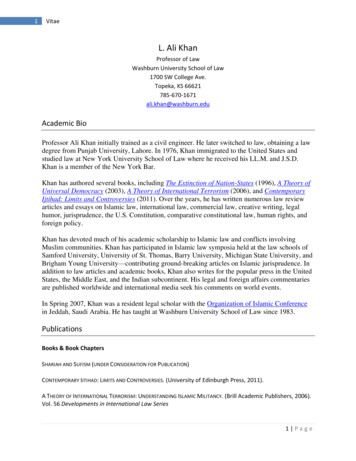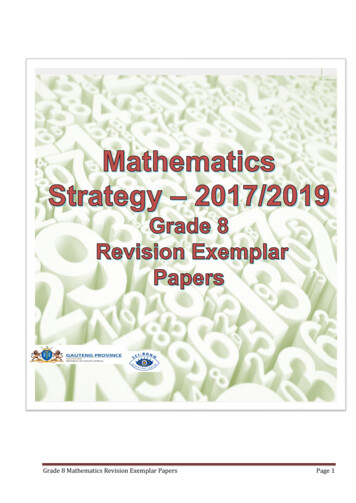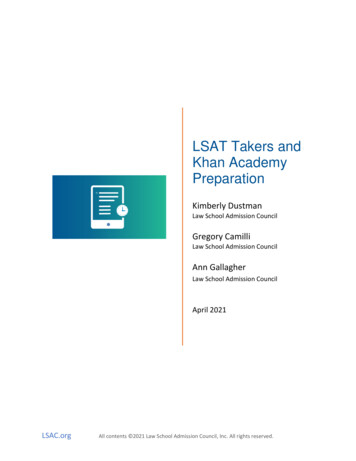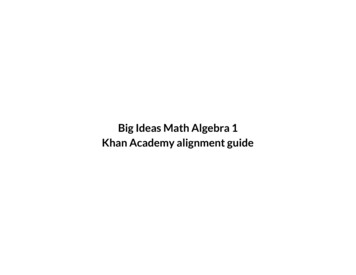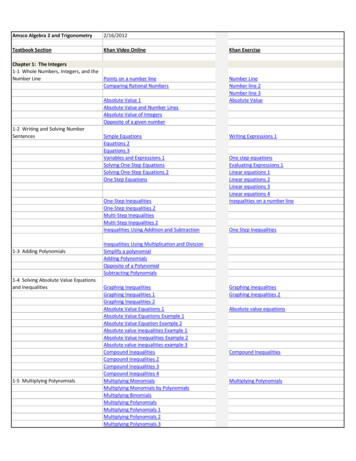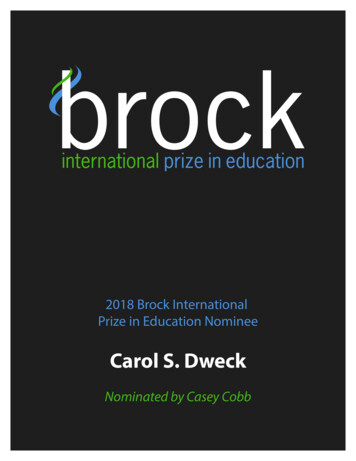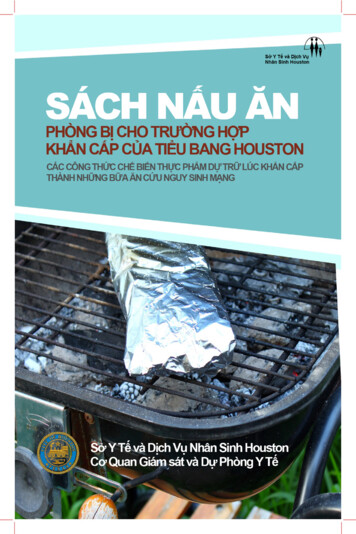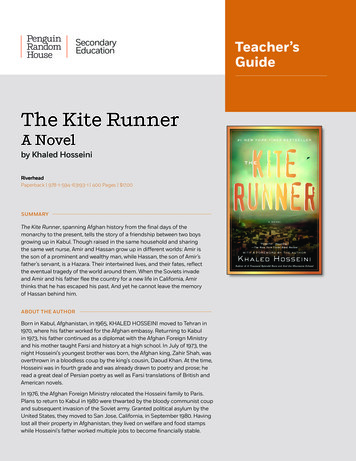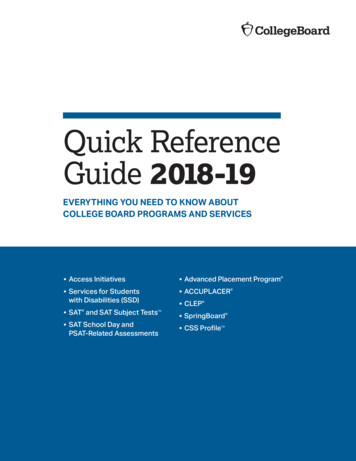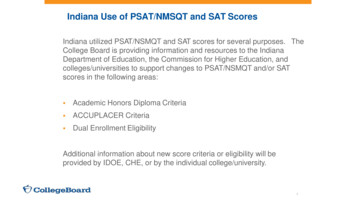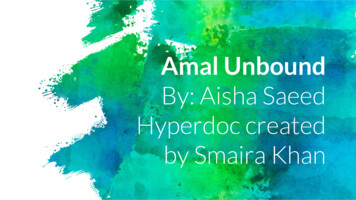
Transcription
Amal UnboundBy: Aisha SaeedHyperdoc createdby Smaira Khan
I notice I wonder.Observe the cover of the book. What do younotice? And what do you wonder?
I notice I wonder.Observe the cover of the book. What do you notice? And what do you wonder?I NOTICE.I WONDER.
Let the blurbhelp youRead the back cover to orient yourself to thebook. Ask yourself, “What’s the structure ofthis text? What will be the most importantissues this story deals with? What problemswill the main character face?
Let the blurb help youQUESTIONSWhat information in the blurbwill help?What will the structure of thebook be, based on what youread?Do you have any ideas about themain problem the character willface?Based on the blurb, what do youthink the theme of the book willbe?ANSWERS
About theAuthorMeet Aisha Saeed.And read some questions and answersabout the book Amal Unbound.If you could send a tweet to theauthor of Amal Unbound, AishaSaeed, what would you say / ask?
Big Idea: ChangeEssential Question: What does it take to createchange?Challenge: Be the change
If everyone decidednothing could change,nothing ever would.
PakistanLet’s start by visiting Pakistan
Drag the green thumb tack to where you think Pakistan is located on the map.LeeElementary
Pakistan
Pakistan
PakistanComplete the following table:What I definitelyknow about PakistanWhat I think I knowabout PakistanWhat I want to knowabout Pakistan
Big Idea: ChangeEssential Question: What does it take to createchange?Challenge: Be the change
WEEK 1
I knew helping family was what a goodeldest daughter did, but this time afterschool with Miss Sadia wasn’t just fun;it was important.
ng1.2.3.4.5.6.7.8.9.10.11.Large scarfSirMs.MomOrange, syrupy dessertShirtsTriangular stuffed appetizerMilk based ice creamLoose pantsShirtDad
VocabularyCreate a slideshow or video ofpictures using the Urdu words.You may use your own picturesor harvest pictures from theweb using safe search practicesand citations.Place your video or presentationhere
Discussion QuestionsFlipgrid: Class Intros Discussion Spark Connect it! Do you think the order of your birth has a role in shaping who you are? Arethere certain responsibilities that come with birth order? If so, what do youthink they are? Why is it so important to Amal’s parents that the new baby is a boy? Amal’s friend, Omar, borrows books from his school library and lends them toAmal because ‘it was no secret that the boys’ school had a much bigger libraryto choose from.’ (p. 11) Why do you think the boys have a bigger library? On page 38, the author ‘personifies’ hope when she writes, ‘But hope was atricky thing. It found its way back to me.’ In these sentences hope is describedas if it has a mind of its own. Did hope find its way back to Amal or is Amal ahopeful person? Answer with reference to examples in the text.
Summary Writing
Summary WritingSomebodyWantedWho is the main character?What does he/she want?ButWhat is the conflict?What’s stopping him/her toget what he/she wants?SoHow does he/she try toresolve the conflict?ThenWhat does he/she do tosolve the conflict?
Summary WritingWrite your summary for the chapters you have read.
Cultural ConnectionsIn the first chapter, Amal and her teacher are having a conversation about some famous poetsof the region. She mentions Ghalib, Rumi and Iqbal. Allama Iqbal is very popular in Pakistaniculture and his poetry has been used as lyrics to popular songs.Conduct a research on Allama Iqbal and share your findings. On the next slide you can heara song that uses Iqbal’s poetry as lyrics.Three facts youlearned1.2.3.Two facts you foundinteresting1.2.One question youhave1.
Cultural ConnectionsKhudi ko kar buland itna ke har taqder se pehleKhuda bande se ye poche bata teri raza kia haiKhudi ko kar buland itna ke har taqder se pehleKhuda bande se ye poche bata teri raza kia haiRaise yourself to such height that before writing your destinyGod asks man himself, “Tell me what is your desire?”Raise yourself to such height that before writing your destinyGod asks man himself, “Tell me what is your desire?”Sitaron se age jahan aur bhi hai aur bhi haiAbhi ishq ke Imtehan aur bhi hai aur bhi haiSitaron se age jahan aur bhi hai aur bhi haiAbhi ishq ke Imtehan aur bhi hai aur bhi haiThere are worlds beyond the starsYour passions will be further testedThere are worlds beyond the starsYour passions will be further testedKhudi ko kar buland itna ke har taqder se pehleKhuda bande se ye poche bata teri raza kia haiRaise yourself to such height that before writing your destinyGod asks man himself, “Tell me what is your desire?”Tu shaheen hai, Tu shaheen hai, Tu shaheen haiTu shaheen hai, Tu shaheen hai Parvaz hai kam tera kam teraTere samne Aasman aur bhi haiTu shaheen he Basera kar Paharon ki chatano perTu shaheen hai tu Shaheen hai tu shaheen haiYouYouYouYouYouKhudi ko kar buland itna ke har taqder se pehleKhuda bande se ye poche bata teri raza kia haiRaise yourself to such height that before writing your destinyGod asks man himself, “Tell me what is your desire?”Khudi ko kar buland itna ke har taqder se pehleKhuda bande se ye poche bata teri raza kia haibata teri raza kia haibata teri raza kia haiRaise yourself to such height that before writing your destinyGod asks man himself, “Tell me what is your desire?”“Tell me what is your desire?”“Tell me what is your desire?”are a falcon, You are a falcon, You are a falconare a falcon, You are a falcon, Your job is to soarhave many skies aheadare a falcon, you live on the peaks of mountainsare a falcon, You are a falcon, You are a falcon
Big Idea: ChangeEssential Question: What does it take to createchange?Challenge: Be the change
WEEK 2
But hope was a tricky thing. It found itsway back to me.
as2.3.4.5.6.CharpaiBajijinn4.5.6.Small round yellow balls eaten as dessert(usually passed out when a baby is born)TeaRound flaky bread usually eaten withsomething (similar to tortillas)A bed made using jute and a metal frameTerm of respect for older sistermonster
VocabularyCreate a slideshow or video ofpictures using the Urdu words.You may use your own picturesor harvest pictures from theweb using safe search practicesand citations.Place your video or presentationhere
Discussion QuestionsFlipgrid: Discussion Spark Connect it! Boys have more opportunities in Amal’s society than Amal and the othergirls in her village. Is this unique to the world Amal lives in? Why or whynot? What are the ways girls and boys are treated differently in hervillage? Have your parents ever placed expectations on you that felt unfair?Describe the situation and how you either worked through it, or how youcould work through it in the future. Amal has to pay a huge price for not giving away or selling herpomegranate to Jawad Sahib. What ethical or moral issues are presentedin this selection? How might they be important to the story’s plot?
ConflictsConflictTypeMan v. SelfExample from the bookInternalAmal wants to help Miss Sadia butshe has to go home to help herfamily.Man v.NatureExternalAmal leaves Jawad Sahib’s housebut gets lost in Hazarabad.Man v.ManExternalAmal refuses to give herpomegranate to Jawad Sahib.ExternalAmal’s family felt sad when a newbaby girl was born because theywanted a boy.Man v.Society
ConflictsDirections: For each week, write down at least one conflict that occurred within the chapter, then write down thetype of conflict in the correct column (either Internal or External). Week one has been completed for you.Types of conflict:1. INTERNAL: Man vs. Self2. EXTERNAL: Man vs. Man, Man vs. Society, Man vs. NatureWeekOneDescription of important conflict1.2.TwoAmal wants to help Miss Sadia but she has togo home to help her family.Amal’s family felt sad when a new baby girlwas born because they wanted a boy.Internal ConflictExternal Conflict1. Man vs. Self2. Man vs Society
Summary WritingWrite your summary for the chapters you have read.
Cultural ConnectionsThese aresome shopsin LahoreandKarachi.
Cultural ConnectionsLahore is a city of 13 gates. Some still exist whereas some have been demolished.
Big Idea: ChangeEssential Question: What does it take to createchange?Challenge: Be the change
WEEK 3
I loved this one. Read it so many times,my father replaced my worn copy witha new one. He didn’t realize I liked thefeel of the old one.
hakbabahookah6.7.8.9.10.Chickpea curryA yogurt and fried onion based curryGrilled meatThin flat bread similar to a tortillaBoneless meat curry usually coveredovernight and eaten as breakfast90 also pronounced navay92VillageTerm used for an old manA device used for smoking
VocabularyCreate a slideshow or video ofpictures using the Urdu words.You may use your own picturesor harvest pictures from theweb using safe search practicesand citations.Place your video or presentationhere
Discussion QuestionsFlipgrid: Discussion Spark Connect it! List the names of people who work at Jawad Sahib’s estate and list theirresponsibilities. Why do you think the author, Aisha Saeed, creates a link betweenNasreen Baji and Amal’s village? How does this affect how you feel aboutNasreen? Nabila is initially very jealous of Amal. What are some of the tricks sheplays on Amal, and why does she play them? How is her situation differentfrom that of many of the other workers at the estate? The author creates a tender moment between Jawad Sahib and Amal inchapter 23. What, in your opinion, is the significance of that moment?
Character TraitsWhat are Character Traits?When we talk about a character, we often describe that character in terms of character traits: descriptiveadjectives like happy or sad that tell us the specific qualities of the character.They're the same kinds of words that we might use to describe ourselves or others, but we're using them todescribe fictional characters in something we've read.How do we find Character Traits?The author may tell us these traits directly, but more often the author will show us these traits in action. Ourjob as readers is to draw a conclusion - or infer - about the character's traits from what the character says,thinks, and does.We might infer a character trait from something a character does only once, or we might draw ourconclusions from a series of things the character says and does. Sometimes a character’s traits may bedifferent by the end of a story than they were at the beginning.
Character TraitsAmalActionsinclude a quote or paraphrase & pg. #Jawad SahibCharacter TraitsRevealedActionsinclude a quote or paraphrase & pg. #Your ChoiceActionsinclude a quote or paraphrase & pg. #Character TraitsRevealedYour ChoiceCharacter TraitsRevealedActionsinclude a quote or paraphrase & pg. #Need help? Click here to see a listof character traitsCharacter TraitsRevealed
Summary WritingWrite your summary for the chapters you have read.
ConflictsDirections: For each week, write down at least one conflict that occurred within the chapter, then write down thetype of conflict in the correct column (either Internal or External).Types of conflict:1. INTERNAL: Man vs. Self2. EXTERNAL: Man vs. Man, Man vs. Society, Man vs. NatureWeekThreeDescription of important conflictInternal ConflictExternal Conflict
Cultural ConnectionsSome villages in Pakistan do not have names. They are assigned anumber. Nabay Chak and Banway Chak actually translates to 90village and 92 village. Do you know numbers in any other ivepaanchtendusYourchoice
Big Idea: ChangeEssential Question: What does it take to createchange?Challenge: Be the change
WEEK 4
But to call me a guest in the only place Iever belonged - the word cut like ajagged stone against my heart.
aarpakoras6.7.8.9.kardhaichickenAnarkali9.10.10.A term of endearment used for someonewho is young or shortA large scarfA - first letter of the urdu alphabetsB - second letter of the urdu alphabetsA single long piece of cloth wrappedaround the body. Worn with a blouseA cloth used to cover hairMarketFried appetizer usually made ofvegetablesChicken made in a wok with tomatoesA very famous shopping area in Lahorenamed after a royal maid
VocabularyCreate a slideshow or video ofpictures using the Urdu words.You may use your own picturesor harvest pictures from theweb using safe search practicesand citations.Place your video or presentationhere
Discussion QuestionsFlipgrid: Discussion Spark Connect it! The mythology surrounding the Khan family introduces us to them ascharacters before they make an appearance in the text. What power do theyhave over the people in Amal’s village, and even over the children who havenever met them? Nabila is very hostile toward Amal at first. What are her reasons for feeling theway she does toward Amal, and how do her feelings ultimately evolve? How has the opinion of the other workers changed about Amal? How did theyfeel when she arrived and how do they feel now? Why has their opinionchanged? Words like “You are strong” and “You’re our guest,” cut like a jagged stoneagainst Amal’s heart. Why do you think Amal felt this way?
ThemeTheme is the message aboutthe topic or big styTheme (The message of thestory)Love is complicated.True friends like you for whoyou really are on the inside.You should never give up.Telling the truth may behard, but it’s the rightdecision to make.Theme Topic
ThemeWhat is the theme of Amal Unbound? Support your claimwith evidence.Subject/BigIdeaEvidence:Theme (The message of the story)
Summary WritingWrite your summary for the chapters you have read.
ConflictsDirections: For each week, write down at least one conflict that occurred within the chapter, then write down thetype of conflict in the correct column (either Internal or External).Types of conflict:1. INTERNAL: Man vs. Self2. EXTERNAL: Man vs. Man, Man vs. Society, Man vs. NatureWeekFourDescription of important conflictInternal ConflictExternal Conflict
Cultural ConnectionsWedding celebrations last for weeks in Pakistan. There are at least 4 ceremonieswith lots of songs and dances. Traditionally matchmaking is arranged by parents.That is why Jawad Sahib’s mom is looking for prospective brides.
Big Idea: ChangeEssential Question: What does it take to createchange?Challenge: Be the change
WEEK 5
I knew learning to read wouldn't change thefact that Fatima was trapped here like I was,cleaning floors, dusting baseboards, andpeeling potatoes. But at least by teaching herto read, I gave her a window to see worldsbeyond ours and a chance to imagine leavingthe walls of this estate and to feel free, even ifit was only for a little while.
atight long pajamas withexcess fabric on the bottommade to look like bangles onthe bottom (churi bangle)
VocabularyCreate a slideshow or video ofpictures using the Urdu words.You may use your own picturesor harvest pictures from theweb using safe search practicesand citations.Place your video or presentationhere
Discussion QuestionsFlipgrid: Discussion Spark Connect it! On page 176, Amal feels Nasreen baaji’s cage is nicer than hers. Whatdoes she mean by this thought? Explain with evidence from the text. Amal has a great relationship with both of her teachers, Miss Sadia andAsif at the literacy center. Who are some of your favorite teachers andhow have they changed you and your views? Do you notice a change is Fatima? How has Amal influenced Fatima? Doesthis relationship benefit Amal? If so, how, explain? In chapter 39, Amal and Asif share their point of views about ‘change’.How are they similar and how are they different?
Tone and MoodMy mother’s voice told me to let this go. Something was off withthis man. Let him have the fruit and walk away. But all I could seewas the red pomegranate and how he grasped it in his palm asthough it was already his. How does this text make you FEEL?What was Amal’s ATTITUDE when the man took herfruit?
Tone and MoodACTIONTASKLook at this image and explain thefeelings you get.The first image.Define Mood and Tone, but first. Watch this video See this slideshowMood:Use Amal Unbound, choose a chapter,and analyze the tone and mood. Providequotes that help support your rationale.Chapter:Tone:Mood:Quotes:Rationale:Here is a list of words for support.Tone:
Summary WritingWrite your summary for the chapters you have read.
ConflictsDirections: For each week, write down at least one conflict that occurred within the chapter, then write down thetype of conflict in the correct column (either Internal or External).Types of conflict:1. INTERNAL: Man vs. Self2. EXTERNAL: Man vs. Man, Man vs. Society, Man vs. NatureWeekFiveDescription of important conflictInternal ConflictExternal Conflict
Cultural ConnectionsFood is an integral part of Pakistan’s social life. Most families enjoy evening teaparties. Notice how Amal prepares a tray for Nasreen Baji’s evening tea.
Big Idea: ChangeEssential Question: What does it take to createchange?Challenge: Be the change
WEEK 6
Making choices even when they scareyou because you know it’s the rightthing to do - that’s bravery
tus eerMeaning1.Rice pudding
VocabularyCreate a slideshow or video ofpictures using the Urdu words.You may use your own picturesor harvest pictures from theweb using safe search practicesand citations.Place your video or presentationhere
Discussion QuestionsFlipgrid: Discussion Spark Connect it! Amal feels guilty when she sees Nasreen Baji’s distress after Jawad andKhan Sahib are arrested. Why does she feel guilty? And should she? On page 218, Amal asks the other servants, ‘Isn’t it a good thing that he’sbeen caught?’ She has never considered the further implications for otherpeople at the estate if the Khan family can no longer employ them. Do youbelieve that Amal has done the right thing. Was her freedom worth morethan the security of many other families? We don’t see Amal reuniting with her family. Instead we see Amal walkingto her village and wondering what will happen next in her life. What doyou think happened next?
Story ElementsWatch this video and then fill out the chart about the five elementsof Amal Unbound.
Story ElementsSetting:Conflict:Plot:Characters:Theme:
Summary WritingWrite your summary for the chapters you have read.
ConflictsDirections: For each week, write down at least one conflict that occurred within the chapter, then write down thetype of conflict in the correct column (either Internal or External).Types of conflict:1. INTERNAL: Man vs. Self2. EXTERNAL: Man vs. Man, Man vs. Society, Man vs. NatureWeekSixDescription of important conflictInternal ConflictExternal Conflict
Cultural ConnectionsThe system of Education is different in Pakistan. Public education is notconsidered high quality. Most Pakistani send their children to private schools. Butthere are organizations that run schools for citizens who cannot afford education.The Citizen’sFoundation USA
Extension Activities Conduct a research on Benazir Bhutto and share with peers.She’s in the Guinness Book for World Records. Find out why:)Conduct a research on Malala Yousafzai and share withpeers.The book ends with Amal heading home unsure about whather future holds. Write a follow up story and share whatAmal is up to now.Write a story from Nabila’s point of view.Plot a timeline of significant events in the novel. Underneatheach event, write a short description of the consequences ofthat event and draw an arrow to any other event thathappened as a direct consequence of it.
Reflection: How can YOU create change inyourself, your family, school, community or theworld?
CREDITSI hope you and your learners enjoy working through Amal Unboundand this HyperDoc. I would like to thank the following educators forthe inspiration. Pernille Ripp for bringing the Global Read Aloud Project to lifeand making it possible for all the amazing educators and learnersto collaborate in a risk free environment. Aisha Saeed for creating such a beautiful character, Amal. Herperseverance knows no limits. The creators of “A Long Walk to Water Curriculum Guide” (LauraConroy, Maddy La Voe, Christina Levey, and Jennifer Wagner) The creators of “The Lemonade War” (Karly Moura, Sean Fahey,and Michelle Waggoner). Slides Carnival for one of my favorite Google Slides template
CREDITSI am so elated that the story is set in my home country. I wanted mylearners to get an inside look into Pakistan. I want them to visualize thesights, sounds and taste of my birth place. I am eternally grateful to thefollowing friends: Taimur and Saba Ghaznavi for sharing their wedding pictures.Aisha and Obaid Khan for sharing their wedding pictures.Hamza Ghaznavi and his ProperGaanda team for allowing me touse their vlog on the 13 gates of Lahore.Shermeen Zaidi for her insight regarding children’s education inLahore, Pakistan.
CREDITSI am very grateful for the following educators. Their support and wordsof wisdom mean a lot to me. Stephanie Richter (@RJLdeskin) for sharing her flipgrid templatefor booktalk.Cassie Knight (SoVeryCassie) for vetting the content.Chantel Kastrounis (@NetZeroLee) for pushing my thinking andthe wonderful ideas related to guiding activities.
Thanks!Any questions?You can find me at:@NetZeroKhanskkhan@coppellisd.com
SlidesCarnival icons are editable shapes.This means that you can: Resize them without losing quality. Change fill color and opacity.Isn’t that nice? :)Examples:
Conflict Type Example from the book Man v. Self Internal Amal wants to help Miss Sadia but she has to go home to help her family. Man v. Nature External Amal leaves Jawad Sahib's house but gets lost in Hazarabad. Man v. Man External Amal refuses to give her pomegranate to Jawad Sahib. Man v. Society External Amal's family felt sad when a new
